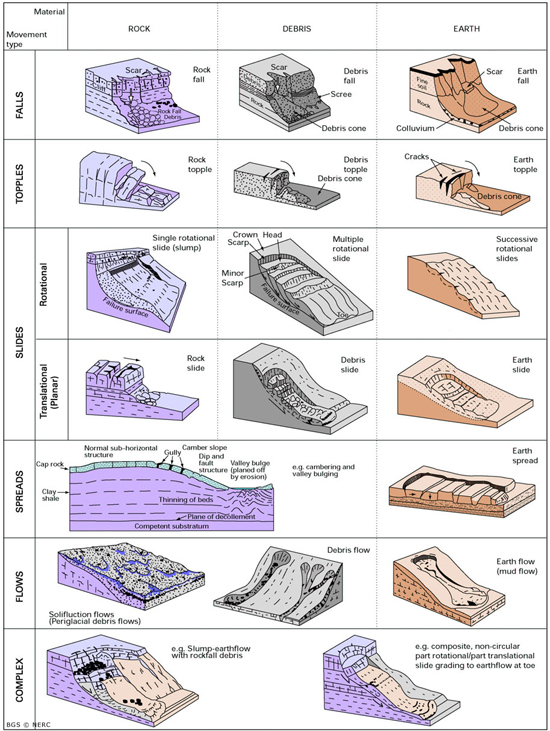Report a landslide to the BGS landslides team
Send us a photo
If you have a photo of the event, please email it to landslides@bgs.ac.uk, quoting the location or tweet us @BGSlandslides.

Terms and conditions
By uploading and depositing photos or materials, you, as depositor, do so on the understanding they may be used/re-used by others.
By depositing photos and materials you take full responsibility:
- to ensure that they are owned by you (or you have permission to do so); and
- understand that liability regarding their use/re-use may lie with you as depositor.
If there are doubts about ownership, check first before making a deposit on BGS citizen science sites.
BGS Citizen Science operates under the code of a:
Creative Commons Attribution-NonCommercial 3.0 Unported License.

Types of landslide
Falls
Rock fall
Masses are detached from steep slope/cliff along surfaces with little or no shear displacement (e.g. joints/fissures) and descend mostly through air by free fall, bouncing or rolling. Material appears mainly as large rock fragments, boulders.
Debris fall
Masses are detached from steep slope/cliff along surfaces with little or no shear displacement (e.g. joints/fissures) and descend mostly through air by free fall, bouncing or rolling. Material appears mainly as stones, cobbles, gravel.
Earth fall
Masses are detached from steep slope/cliff along surfaces with little or no shear displacement (e.g. joints/fissures) and descend mostly through air by free fall, bouncing or rolling. Material appears mainly as mud.
Topples
Rock topple
Movement by forward rotation about a pivot point. Material appears mainly as large rock fragments, boulders.
Debris topple
Movement by forward rotation about a pivot point. Material appears mainly as stones, cobbles, gravel.
Earth topple
Movement by forward rotation about a pivot point. Material appears mainly as mud.
Rotational Slide
Rotational rock slide
Rotational slides (slumps): masses slide outwards and downwards on one or more concave-upward failure surfaces that impart a backward tilt to the slipping mass, which sinks at the rear and heaves at the toe. Material appears mainly as large rock fragments, boulders.
Rotational debris slide
Rotational slides (slumps): masses slide outwards and downwards on one or more concave-upward failure surfaces that impart a backward tilt to the slipping mass, which sinks at the rear and heaves at the toe. Material appears mainly as stones, cobbles, gravel.
Rotational earth slide
Rotational slides (slumps): masses slide outwards and downwards on one or more concave-upward failure surfaces that impart a backward tilt to the slipping mass, which sinks at the rear and heaves at the toe. Material appears mainly as mud.
Translational slide
Translational rock slide
Translational (planar) slides: movements occur along planar failure surfaces that may run more-or less parallel to the slope. Material appears mainly as large rock fragments, boulders.
Translational debris slide
Translational (planar) slides: movements occur along planar failure surfaces that may run more-or less parallel to the slope. Material appears mainly as stones, cobbles, gravel.
Translational earth slide
Translational (planar) slides: movements occur along planar failure surfaces that may run more-or less parallel to the slope. Material appears mainly as mud.
Spreads
Rock/Debris spread
Spreads involve the fracturing and lateral extension of coherent rock or soil masses due to plastic flow or liquefaction of subjacent material. Material appears mainly as large rock fragments, boulders, stones, cobbles, gravel.
Earth spread
Spreads involve the fracturing and lateral extension of coherent rock or soil masses due to plastic flow or liquefaction of subjacent material. Material appears mainly as mud.
Flow
Rock flow
Slow to rapid movements of saturated or dry materials which advance by flowing like a viscous fluid, usually following an initial sliding movement. Some flows may be bounded by basal and marginal shear surfaces but dominant movement of the displaced material is by flowage. Material appears mainly as large rock fragments, boulders.
Debris flow
Slow to rapid movements of saturated or dry materials which advance by flowing like a viscous fluid, usually following an initial sliding movement. Some flows may be bounded by basal and marginal shear surfaces but dominant movement of the displaced material is by flowage. Material appears mainly as stones, cobbles, gravel.
Earth flow
Slow to rapid movements of saturated or dry materials which advance by flowing like a viscous fluid, usually following an initial sliding movement. Some flows may be bounded by basal and marginal shear surfaces but dominant movement of the displaced material is by flowage. Material appears mainly as mud.
Complex
Complex
Complex slides: involve a type of movement style that combines two or more of the main movement types (fall, topple, slide, spread, flow) occurring in sequence. Complexity may be indicated by combining the main movement terms, e.g. complex rotational earth slide-earth flow (or complex slump-earth flow).


